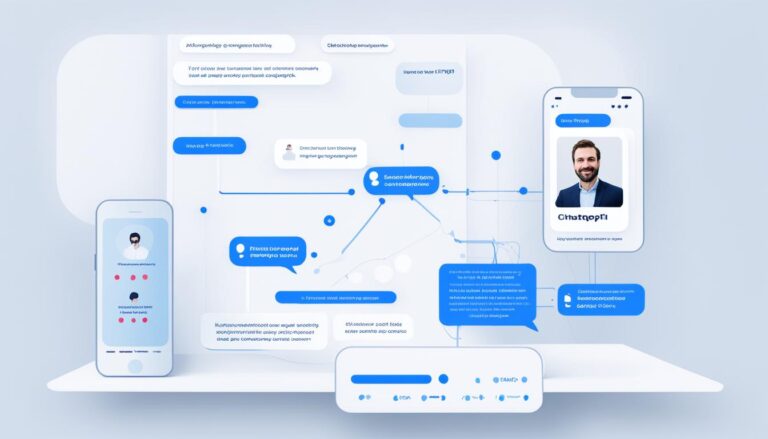
Photo by Andrew Neel on <a href="https://www.pexels.com/photo/monitor-screen-with-openai-logo-on-white-background-15863000/" rel="nofollow">Pexels.com</a>
Conversational AI applications have become increasingly popular in recent years, with virtual assistants and chatbots being used for customer service, personal assistants, and even mental health counseling. The success of these applications heavily relies on their ability to understand and respond to natural language. This is where advanced natural language processing (NLP) techniques such as GPT-3 come into play.
GPT-3 – A Game-Changer in Conversational AI
GPT-3, short for Generative Pre-trained Transformer 3, is an advanced NLP model developed by OpenAI. It has been hailed as a game-changer in the field of conversational AI due to its ability to generate human-like responses in real-time. GPT-3 has been pre-trained on a massive corpus of data, which allows it to understand and generate natural language at an unprecedented level of accuracy and fluency.
One of the key advantages of GPT-3 is its ability to perform a wide range of natural language tasks, such as language translation, summarization, and sentiment analysis. This makes it an ideal tool for developing conversational AI applications that can understand and respond to a diverse range of user inputs.
Real-World Examples of GPT-3 Powered Conversational AI Applications
Let’s take a look at some real-world examples of GPT-3 powered conversational AI applications:

1. Customer Service Chatbots: Customer service chatbots powered by GPT-3 and advanced natural language processing techniques have become increasingly popular in recent years due to their ability to provide quick, accurate, and personalized responses to customer queries in real-time. These chatbots can handle a wide range of tasks, such as answering common questions, resolving issues, and even making product recommendations.
One of the key advantages of customer service chatbots is their ability to provide 24/7 support to customers without any human intervention. This means that customers can get the help they need at any time, regardless of whether it’s during business hours or not. Moreover, chatbots can handle multiple customer queries simultaneously, reducing wait times and improving customer satisfaction.
Another advantage of customer service chatbots is their ability to learn and improve over time. With machine learning algorithms, chatbots can analyze customer interactions, understand common issues, and make improvements to their responses accordingly. This leads to a more personalized and effective customer experience.
Additionally, customer service chatbots can be integrated with other technologies such as speech recognition and natural language understanding to enhance their capabilities. For example, chatbots can use sentiment analysis to understand the emotional state of the customer and provide more empathetic responses.
Overall, customer service chatbots powered by GPT-3 and advanced natural language processing techniques offer a scalable and cost-effective solution for businesses to provide high-quality customer support. They can handle a large volume of queries, reduce wait times, and improve customer satisfaction, ultimately leading to increased customer loyalty and sales.

2. Personal Assistants: Personal assistants are another popular application of conversational AI that can benefit greatly from GPT-3 and advanced natural language processing techniques. Personal assistants can perform a variety of tasks, such as scheduling appointments, setting reminders, making reservations, and even conducting online research.
With GPT-3 and natural language processing, personal assistants can provide more accurate and personalized responses to user queries. They can understand the context of a conversation and respond appropriately, making the interaction more natural and human-like.
Personal assistants can also benefit from the ability to learn and improve over time. By analyzing user interactions and feedback, personal assistants can make improvements to their responses and better understand user preferences and habits.
Moreover, GPT-3-powered personal assistants can be integrated with other technologies such as speech recognition and natural language understanding to enhance their capabilities. For example, personal assistants can use speech recognition to interact with users through voice commands, making the interaction even more seamless and natural.
One of the key advantages of personal assistants is their ability to streamline tasks and reduce cognitive load for users. With a personal assistant, users can delegate certain tasks and have them handled automatically, freeing up time and mental resources for other activities.
Overall, personal assistants powered by GPT-3 and advanced natural language processing techniques offer a convenient and efficient way for users to manage their daily tasks and improve their productivity. They can provide personalized and natural interactions, learn and improve over time, and be integrated with other technologies to enhance their capabilities.

3. Mental Health Counseling: Mental health counseling is a critical area where GPT-3 and advanced natural language processing techniques can be used to improve access to care and provide more personalized support to individuals.
One of the key advantages of using conversational AI for mental health counseling is the ability to provide 24/7 support to individuals who may not have access to traditional therapy services or who may feel uncomfortable seeking help in person. With a chatbot or virtual assistant, individuals can access support at any time from the privacy and comfort of their own homes.
Moreover, chatbots and virtual assistants can provide a non-judgmental and empathetic environment for individuals to discuss their mental health concerns. They can use natural language processing to understand the context and emotional state of the individual and respond appropriately, providing support and resources tailored to their specific needs.
Another advantage of using GPT-3 and natural language processing for mental health counseling is the ability to scale resources and reach a larger audience. With the growing demand for mental health services, chatbots and virtual assistants can provide an efficient and cost-effective way to meet the needs of a large number of individuals.
Additionally, chatbots and virtual assistants can be integrated with other technologies such as sentiment analysis and emotion recognition to enhance their capabilities. For example, a chatbot could use sentiment analysis to identify negative emotions in an individual’s text messages and respond with appropriate resources or referrals.
Overall, GPT-3 and advanced natural language processing techniques offer a promising avenue for providing accessible and personalized mental health support. By leveraging the power of conversational AI, individuals can access support at any time, receive non-judgmental and empathetic responses, and benefit from the scalability and efficiency of technology.
Advanced NLP Techniques Beyond GPT-3
While GPT-3 is undoubtedly a powerful tool for developing conversational AI applications, it is not the only advanced NLP technique available. Other techniques such as sentiment analysis, natural language understanding (NLU), and natural language generation (NLG) can also be used to enhance the capabilities of conversational AI applications.
For example, sentiment analysis can help chatbots understand the emotional state of the user and respond accordingly. NLU techniques can help chatbots understand the intent behind user inputs and provide appropriate responses. NLG techniques can be used to generate human-like responses that are more engaging and personalized.
Conclusion
Advanced NLP techniques such as GPT-3 have revolutionized the field of conversational AI by enabling the development of applications that can understand and respond to natural language in real-time. With the increasing demand for conversational AI applications in various industries, it is essential to leverage these advanced techniques to build more powerful and engaging applications. The future of conversational AI looks bright, with the promise of more advanced NLP techniques and models on the horizon.





